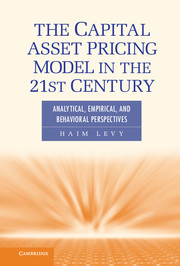 The Capital Asset Pricing Model in the 21st Century
The Capital Asset Pricing Model in the 21st Century Book contents
- Frontmatter
- Contents
- Preface
- 1 Introduction
- 2 Expected Utility Theory
- 3 Expected Utility and Investment Decision Rules
- 4 The Mean-Variance Rule (M-V Rule)
- 5 The Capital Asset Pricing Model
- 6 Extensions of the Capital Asset Pricing Model
- 7 The Capital Asset Pricing Model Cannot Be Rejected
- 8 Theoretical and Empirical Criticism of the Mean-Variance Rule
- 9 Prospect Theory and Expected Utility
- 10 Cumulative Decision Weights
- 11 The Mean-Variance Rule, the Capital Asset Pricing Model, and the Cumulative Prospect Theory
- References
- Name Index
- Subject Index
5 - The Capital Asset Pricing Model
Published online by Cambridge University Press: 05 June 2012
- Frontmatter
- Contents
- Preface
- 1 Introduction
- 2 Expected Utility Theory
- 3 Expected Utility and Investment Decision Rules
- 4 The Mean-Variance Rule (M-V Rule)
- 5 The Capital Asset Pricing Model
- 6 Extensions of the Capital Asset Pricing Model
- 7 The Capital Asset Pricing Model Cannot Be Rejected
- 8 Theoretical and Empirical Criticism of the Mean-Variance Rule
- 9 Prospect Theory and Expected Utility
- 10 Cumulative Decision Weights
- 11 The Mean-Variance Rule, the Capital Asset Pricing Model, and the Cumulative Prospect Theory
- References
- Name Index
- Subject Index
Summary
Introduction
In the preceding chapters, we have discussed the theoretical foundations of the Mean-Variance (M-V) rule and analyzed the conditions under which one can safely employ this rule. We also demonstrated cases where the M-V rule is not allowed to be employed because it may yield paradoxical results. The analysis of the validity of the M-V analysis is of crucial importance because the M-V framework is the foundation of the Capital Asset Pricing Model (CAPM), to which we devote a substantial part of this book. Moreover, the CAPM assumes that investors make investment decisions by the M-V rule and is based on the M-V efficiency analysis. In this chapter, we assume that investors make their portfolio choices by the M-V rule and investigate the implication of the M-V portfolio selection framework to several issues, issues that pave the way to the development of the CAPM:
What is the optimal portfolio diversification strategy when only risky assets are available in the markets? Does the optimal choice vary across investors?
What is the optimal diversification strategy in risky assets when unlimited borrowing and lending at the risk-free asset prevail? Does it vary across investors?
Which economic factor determines how one should diversify between the risky asset and the riskless asset?
What is the risk index of an asset when only one risky asset is held in the portfolio?
What is the risk index of an individual asset when many other risky assets are held with the asset under consideration in the same portfolio? What is the risk index of the portfolio in such a case?
Employing the M-V rule and adding some additional assumptions regarding the efficiency of the market, what are the implied equilibrium prices of the various risky assets? What is the risk return equilibrium relation?
The answers to the first five questions facilitate the analysis corresponding to the sixth question, the one that constitutes the core of this chapter, where an equilibrium pricing model is derived, well known as the CAPM. This model was developed by Sharpe and Lintner, and it is mainly for this work that Sharpe won the Nobel Laureate in 1990.
- Type
- Chapter
- Information
- The Capital Asset Pricing Model in the 21st CenturyAnalytical, Empirical, and Behavioral Perspectives, pp. 117 - 155Publisher: Cambridge University PressPrint publication year: 2011
- 2
- Cited by


